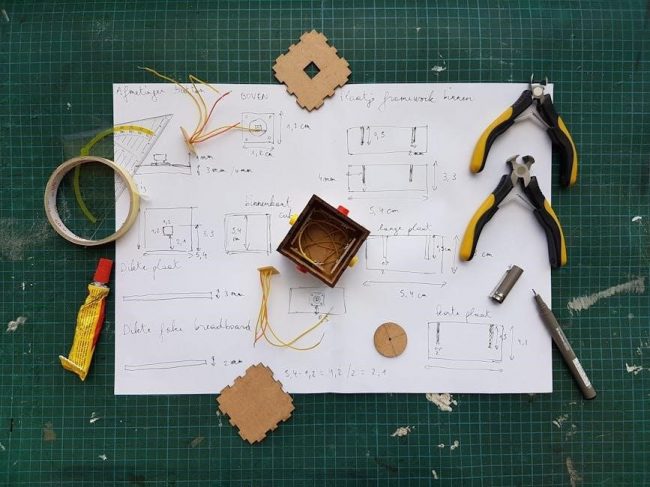Manual paper cutters are essential tools for precise cutting of paper, available in various types like guillotine, rotary, and stack cutters, ideal for offices, schools, and crafting projects.
1.1 Definition and Purpose
A manual paper cutter is a tool designed to cut paper precisely, using a blade and a manual operation mechanism. Its primary purpose is to trim, slice, or divide paper into desired sizes or shapes. Widely used in offices, schools, and crafting, these cutters ensure accuracy and safety, making them essential for professional and creative projects requiring clean, precise cuts.
1.2 Brief History and Evolution
Manual paper cutters have evolved from simple guillotine-style tools to sophisticated devices with advanced features. Early models focused on basic cutting, while modern designs emphasize precision, safety, and durability. Innovations like adjustable blades and ergonomic handles have enhanced functionality, catering to diverse needs in offices, schools, and crafting. Historical advancements reflect a commitment to improving efficiency and user experience.

Types of Manual Paper Cutters
Manual paper cutters come in various types, including guillotine, rotary, stack, and craft cutters, each designed for specific tasks and offering unique benefits for precise paper trimming needs.
2.1 Guillotine Cutters
Guillotine cutters are the most common type, featuring a sharp blade that descends to cut paper. They can handle large stacks, making them ideal for offices and print shops. Known for their simplicity and efficiency, these cutters are designed for heavy-duty use and offer precise, clean cuts, making them a favorite among professionals and crafters alike for various paper-trimming tasks.
2.2 Rotary Cutters
Rotary cutters are versatile tools with a rotating blade, ideal for precise straight or curved cuts. Popular in crafting and scrapbooking, they feature a circular edge for smooth, controlled trimming. These cutters are lightweight, portable, and perfect for intricate designs, making them a favorite for DIY projects and detailed paper work, ensuring accuracy and creativity in various applications.
2.3 Stack Cutters
Stack cutters are designed for cutting multiple sheets of paper simultaneously, offering high efficiency for bulk tasks. They feature a stable base and a protective guard for safety, ensuring precise and clean cuts. Ideal for professional settings like offices and print shops, stack cutters are durable tools that handle large volumes of paper with ease, making them a practical choice for heavy-duty applications.
2.4 Craft and Scrapbooking Cutters
Craft and scrapbooking cutters are specialized tools designed for intricate, precise cuts in creative projects. They often feature adjustable blades, curved edges, and decorative patterns, allowing for unique designs. These cutters are popular among DIY enthusiasts and artists, offering versatility and control for detailed work, making them essential for crafting and scrapbooking activities where creativity and precision are key.

Design and Mechanism
Manual paper cutters feature durable designs with high-carbon steel blades, ergonomic handles, and alignment grids for precise cuts. Safety mechanisms ensure efficient and secure operation.
3.1 Key Components (Blade, Alignment Grid, Handle)
The blade, typically made of high-carbon steel, ensures precise cuts. The alignment grid provides visual guidance for accuracy, while the ergonomic handle offers a comfortable grip and control during operation.
3.2 How the Cutting Mechanism Works
Pressing the handle activates the blade, which moves downward in a controlled motion. The alignment grid ensures paper is positioned correctly, while the blade slices through the stack. Leverage and pressure are applied to achieve precise, clean cuts, with the backgauge holding the paper firmly in place during the process.
Safety Features and Precautions
Manual paper cutters include protective guards and blade covers to prevent accidents. Always handle blades carefully, keep fingers away, and ensure stable positioning for safe cutting.
4.1 Safety Tips for Handling Blades
Always wear gloves when handling blades to prevent cuts. Ensure blades are securely locked when not in use. Keep fingers away from cutting edges and maintain a stable grip. Regularly inspect blades for damage and replace them if worn. Store blades separately from other tools to avoid accidents. Never leave sharp blades unattended, especially near children.
4.2 Protective Features in Modern Cutters
Modern manual paper cutters often include safety guards to shield fingers from blades. Some models feature automatic blade locks to prevent accidental cuts. Ergonomic designs reduce strain during use, while protective covers ensure blades remain secure when not in operation. These features enhance user safety and extend the cutter’s lifespan, making them more reliable for regular use.
Maintenance and Care
Regular cleaning and lubrication of blades ensure smooth operation. Sharpening or replacing dull blades maintains cutting efficiency. Proper storage prevents rust and extends the cutter’s lifespan.
5.1 Cleaning and Lubricating the Cutter
Regularly clean the cutter by wiping surfaces with a soft cloth to remove dust and debris. For tougher stains, use a mild detergent and water solution. Dry thoroughly to prevent rust. Lubricate moving parts with silicone-based sprays to ensure smooth operation and extend the cutter’s lifespan. Proper maintenance enhances performance and prevents wear and tear.
5.2 Sharpening or Replacing the Blade
Sharpening the blade with a sharpening stone or replacing it when overly worn ensures optimal performance. Regular lubrication prevents rust and maintains sharpness. For the best results, sharpen in small, consistent strokes and check the blade’s alignment post-sharpening. Consider professional sharpening for precise edges. Always follow manufacturer guidelines for replacement to guarantee safety and efficiency.
How to Use a Manual Paper Cutter
Align the paper, set the backgauge, and gently lower the blade for clean cuts. Lubricate the blade regularly to maintain sharpness and ensure smooth operation.
6.1 Step-by-Step Guide to Cutting Paper
Place the paper on the cutter, aligning it with the grid for accuracy. 2. Adjust the backgauge to the desired length. 3. Hold the handle firmly and lower the blade smoothly. 4. Ensure the blade cuts through evenly. 5. Store the cutter safely after use. Always wear gloves and work in a clear, stable environment for precise, safe cuts.
6.2 Tips for Achieving Accurate Cuts
Align the paper properly using the cutter’s grid or measuring guide. Double-check measurements before cutting. Ensure the blade is sharp for clean cuts. Apply steady, even pressure on the handle. Use the backgauge to maintain consistent cut lengths. Work in a stable, flat surface to prevent movement. Small adjustments and test cuts can help achieve precise results.
Choosing the Right Manual Paper Cutter
Selecting the right manual paper cutter involves considering factors like size, capacity, and material. Opt for models with high-quality blades for durability and precise cuts.
7.1 Factors to Consider (Size, Capacity, Material)
When choosing a manual paper cutter, consider size for workspace compatibility, capacity for cutting volume, and material for durability. Blades should be high-carbon steel for precision cuts. Handles should be ergonomic for comfort, and alignment grids essential for accuracy. Opt for models with sturdy bases to prevent movement during use, ensuring safety and consistent results.
7.2 Common Brands and Their Features
Popular brands like Dahle, Swingline, and Kutrimmer offer high-quality manual paper cutters. Dahle cutters are known for their precision and durable construction, while Swingline models often include ergonomic handles and safety features. Fiskars and Rotary cutters are favored for their sharp blades and ease of use, catering to both professional and crafting needs with reliable performance and long-lasting durability.
Manual vs. Automatic Paper Cutters
Manual cutters are cost-effective and ideal for small tasks, while automatic cutters offer faster, hands-free operation, making them better for high-volume use despite higher costs.
8.1 Pros and Cons of Manual Cutters
Manual cutters are cost-effective, portable, and eco-friendly, requiring no electricity. They are ideal for small-scale tasks and precise cuts but can be time-consuming for large volumes and physically demanding, lacking automation benefits.
8.2 When to Opt for Automatic Cutters
Automatic cutters are ideal for high-volume tasks, offering speed and efficiency. They handle large stacks effortlessly and provide consistent precision, making them suitable for professional environments. Automatic models reduce physical effort and are better for repetitive cutting, ensuring accuracy and time savings in industrial or heavy-duty applications where manual cutters may fall short.

Accessories for Manual Paper Cutters
Accessories for manual paper cutters include replacement blades, cutting mats, and safety gloves. These enhance functionality and user safety, ensuring precise and secure cutting experiences every time.
9.1 Replacement Blades and Parts
Replacement blades and parts are crucial for maintaining the performance of manual paper cutters. High-quality blades, often made from durable materials like high-carbon steel, ensure precise cuts. Regularly replacing dull blades enhances cutting efficiency and safety. Additionally, spare parts such as alignment grids and handle components can be replaced to restore functionality. Always consult the user manual for proper installation and compatibility.
9.2 Cutting Mats and Other Tools
9.2 Cutting Mats and Other Auxiliary Tools
Cutting mats provide a durable, protective surface for manual paper cutting, preventing damage to blades and workspaces. Auxiliary tools like alignment rulers and smoothing tools enhance precision and efficiency. These accessories are essential for professionals and crafters, ensuring accurate cuts and extending the lifespan of the cutter. They complement the cutter’s functionality, making the cutting process safer and more professional.
Environmental and Cost Considerations
Manual paper cutters are eco-friendly, requiring no electricity, and are cost-effective, offering long-term savings compared to automatic models while reducing environmental impact through energy efficiency.
10.1 Eco-Friendly Aspects of Manual Cutters
Manual paper cutters are environmentally friendly as they require no electricity, reducing carbon footprint. Their durable construction minimizes waste and the need for frequent replacements, making them a sustainable choice for eco-conscious users seeking to lower their environmental impact while maintaining efficiency in paper cutting tasks.
10.2 Cost-Effectiveness Compared to Automatic Models
Manual paper cutters are highly cost-effective compared to automatic models, offering lower purchase prices and no electricity costs. They require less maintenance and repair, reducing long-term expenses. Their simplicity and durability ensure extended usability, making them a budget-friendly choice for individuals and businesses seeking reliable paper-cutting solutions without the financial burden of advanced automated systems.
Common Uses of Manual Paper Cutters
Manual paper cutters are widely used in offices, schools, and crafting for precise paper trimming, scrapbooking, and DIY projects, offering versatility and reliability for various tasks.
11.1 Office and Professional Settings
Manual paper cutters are indispensable in offices for trimming documents, cutting large paper stacks, and ensuring precise edges. They are also used in professional print shops for accurate trimming of printed materials. Their durability and efficiency make them ideal for high-volume tasks, providing consistent results and maintaining productivity in fast-paced work environments.
11.2 Crafting, Scrapbooking, and DIY Projects
Manual paper cutters are versatile tools for crafting and scrapbooking, offering precise cuts for photos, cards, and decorative designs. DIY enthusiasts use them to trim materials like cardboard, fabric, and specialty papers. Their compact size and ease of use make them ideal for detailed, creative projects, allowing for accurate cuts and artistic freedom in various craft applications.

Troubleshooting Common Issues
Troubleshooting common issues involves addressing jams, dull blades, and misalignment. Regular maintenance and blade sharpening help prevent these problems and ensure optimal performance.
12.1 Jamming or Uneven Cuts
Jamming or uneven cuts often result from misaligned blades, debris buildup, or overloading the cutter. Regular cleaning, blade sharpening, and proper alignment can prevent these issues. Ensuring the paper stack is evenly loaded and within capacity limits also helps achieve smooth, precise cuts. Lubricating moving parts and checking for wear on components can further minimize jamming and uneven results.
12.2 Dull Blades and How to Address Them
Dull blades are a common issue, causing uneven cuts and jamming. Regular sharpening or replacing blades with high-quality alternatives can resolve this. Sharpening stones or professional services are effective solutions. Always follow manufacturer guidelines for replacement to ensure optimal performance and safety. Proper blade maintenance extends the cutter’s lifespan and maintains cutting efficiency.
Storage and Transportation Tips
Store manual paper cutters in a dry, clean environment, away from direct sunlight. Cover to protect from dust and ensure secure handling during transportation to prevent damage.
13.1 Proper Storage to Maintain Functionality
Store manual paper cutters in a clean, dry environment to prevent rust and dust buildup. Keep them upright or flat in a secure location, away from direct sunlight. Cover the blade with a guard or protective casing to maintain sharpness and safety. Regularly inspect for wear and tear, and ensure the cutter is firmly secured during transportation to avoid damage.
13.2 Safe Handling During Transportation
When transporting manual paper cutters, ensure they are securely packaged in sturdy cases or boxes to prevent movement and damage. Protect the blade with a safety cover to avoid accidents. Handle the cutter with care, avoiding drops or impacts. Use padding materials to cushion the tool during transit. Always transport the cutter in an upright position to maintain balance and stability.
Innovations in Manual Paper Cutters
Modern manual paper cutters feature ergonomic designs, advanced safety mechanisms, and precision engineering, enhancing usability and efficiency for various professional and crafting applications.
14.1 Modern Features and Designs
Modern manual paper cutters incorporate ergonomic handles, safety blade locks, and precision alignment grids for accuracy. Durable materials like high-carbon steel ensure longevity, while adjustable backgauges enhance versatility. These designs cater to both professional and crafting needs, offering efficiency and reliability without compromising on safety or performance.
14.2 Technological Advancements in Manual Cutting Tools
Technological advancements have introduced high-carbon steel blades for durability and laser-aligned grids for precision. Automatic blade locks and ergonomic grips enhance safety and comfort. Some models now feature adjustable tension controls and silent operation mechanisms, making manual cutters more efficient and user-friendly while maintaining their reliability for various cutting tasks.
Manual paper cutters remain essential tools, offering precision and versatility for various tasks. Their cost-effectiveness and reliability make them ideal for offices, schools, and crafting projects alike.
15.1 Summary of Key Points
Manual paper cutters are reliable, versatile tools for precise cutting, offering cost-effectiveness and ease of use. They are ideal for offices, schools, and crafting projects, providing consistent results. Their durability and minimal maintenance make them a practical choice for various tasks. Whether for professional or creative purposes, manual cutters remain essential for achieving clean, accurate cuts efficiently.
15.2 Final Thoughts on Manual Paper Cutter Usage
Manual paper cutters remain indispensable tools for precise, efficient cutting. Their reliability, versatility, and cost-effectiveness make them ideal for offices, schools, and crafting projects. Proper safety precautions and regular maintenance ensure longevity and optimal performance. Whether for professional or creative tasks, manual cutters provide consistent results, making them a valuable addition to any workspace or craft room.

















































